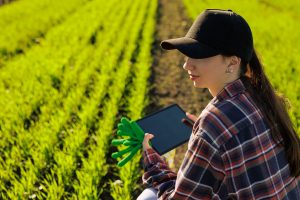As the world population is projected to reach over 8 billion people in 2030, one of the major societal challenges faced across the globe will be sufficient, safe, and sustainable food. International experts in agriculture and food production increasingly look towards specialised digital technologies, in particular edge AI, as a promising option. That is the conclusion reached by a group of researchers from four continents, among them Dr Philippe Delfosse of the University of Luxembourg, in their paper “Leveraging edge artificial intelligence for sustainable agriculture”, published in Nature Sustainability. The strong interdisciplinary nature of the article covers agricultural science, environmental science, computer science, and social sciences including economics.
Edge AI applies models or algorithms directly on local autonomous devices, allowing users to collect and process data without being connected to high resource infrastructure. While edge AI has the potential to improve agricultural production efficiency, yield, quality, and safety through enhancing farming practices, the application of edge AI faces several challenges until these promising outputs can be achieved.
Leveraging edge AI at the intersection of food production and sustainability
“When reflecting on global food production, it is important to consider, in a comprehensive and systemic way, the distinct characteristics of agricultural production systems in northern and southern regions of the planet,” explains Dr. Delfosse, one of the co-authors. “That was a monumental exercise, lasting two years, triggering animated scientific debates among us to reconcile technical and human development. For the ten authors originating from four continents and distinct disciplines, it was a truly enriching human experience.”
While AI is already used in various aspects of agriculture, it is still in its infancy. What we need is to think about the entire process through the lens of an adapted, applicable, and 24/7 system, to make food production sustainable for future populations. Considering, for example, hardware, current AI infrastructure relies on expensive, energy demanding, or heavy cloud computing platforms, unsuitable for agricultural practices. One possible solution put forward by experts is computation-in-memory (CIM), based on emerging non-volatile devices. CIM allows data storage and computation and supports significant parallel simulation at a high-efficiency rate, making it a handy solution for agricultural applications.
Such solutions allow data processing 24/7 on a local level, prerequisites in the agricultural setting. However, the criteria of high-quality data and affordable, energy-efficient infrastructure, and robust materials, must be met for smooth functioning in often harsh environments. The potential of edge AI in agriculture is manifold as it will allow increasing productivity in a sustainable manner, improving the use of available resources (such as water, chemical products but also humans), and including sustainable considerations (crop diversity, environmental and ecological considerations…) in its applications.
In practice, vision systems, such as a close-range multimodal camera system, should supplement human vision, bringing automation, objectivity, and additional agronomic information to better understand crop growth dynamics. The Internet of Things offers many opportunities that can be adapted precisely for food production, transformation, logistics and retailing. One example already introduced in Luxembourg is IoT monitoring in viticulture that anticipates and helps manage vineyard diseases.
“My fellow co-authors are all enthusiastic about the deployment of edge AI to improve food production systems across the globe,” says Philippe Delfosse. “Yet we analysed this potential very honestly and from all possible angles, considering the significant challenges ahead to adapt the technology, making it robust, autonomous, energy, and resource-efficient, and globally beneficial for all farmers, whether they are small-scale farmers in Africa or large landowners in North America; a memorable team effort.”
The publication has already garnered significant attention and ranks among the top 5% of all research outputs ever tracked by Altmetric. The leading author is Moussa El Jarroudi from the University of Liège. The perspective also includes co-authors from the University of Luxembourg and the Lycée Technique Agricole in Luxembourg.
Moussa El Jarroudi, Louis Kouadio, Philippe Delfosse, Clive H. Bock, Anne-Katrin Mahlein, Xavier Fettweis, Benoit Mercatoris, Frank Adams, Jillian M. Lenné & Said Hamdioui, Leveraging edge artificial intelligence for sustainable agriculture, Nature Sustainability (2024).
doi.org/10.1038/s41893-024-01352-4.
